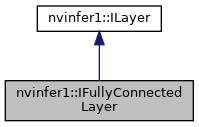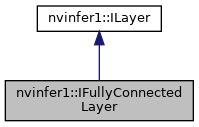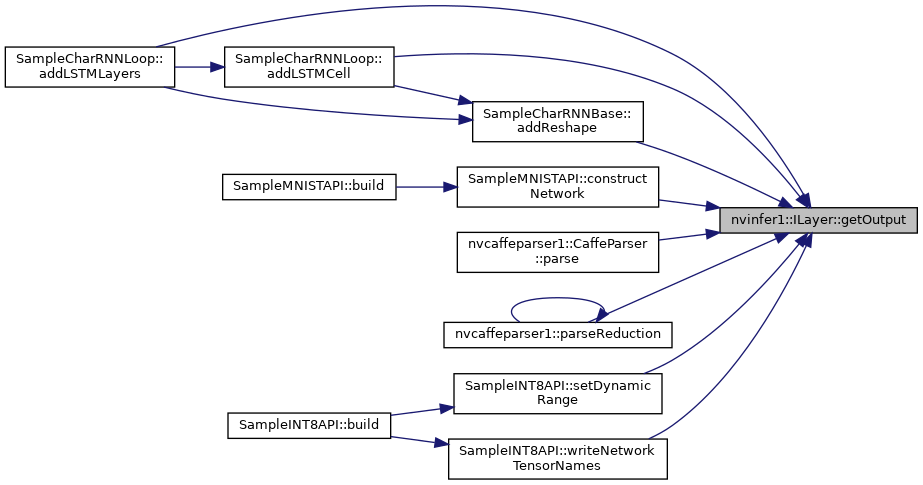A fully connected layer in a network definition. This layer expects an input tensor of three or more non-batch dimensions. The input is automatically reshaped into an MxV tensor X, where V is a product of the last three dimensions and M is a product of the remaining dimensions (where the product over 0 dimensions is defined as 1). For example:
More...
A fully connected layer in a network definition. This layer expects an input tensor of three or more non-batch dimensions. The input is automatically reshaped into an MxV tensor X, where V is a product of the last three dimensions and M is a product of the remaining dimensions (where the product over 0 dimensions is defined as 1). For example:
- If the input tensor has shape
{C, H, W}, then the tensor is reshaped into {1, C*H*W}.
- If the input tensor has shape
{P, C, H, W}, then the tensor is reshaped into {P, C*H*W}.
The layer then performs the following operation:
Y := matmul(X, W^T) + bias
Where X is the MxV tensor defined above, W is the KxV weight tensor of the layer, and bias is a row vector size K that is broadcasted to MxK. K is the number of output channels, and configurable via setNbOutputChannels(). If bias is not specified, it is implicitly 0.
The MxK result Y is then reshaped such that the last three dimensions are {K, 1, 1} and the remaining dimensions match the dimensions of the input tensor. For example:
- If the input tensor has shape
{C, H, W}, then the output tensor will have shape {K, 1, 1}.
- If the input tensor has shape
{P, C, H, W}, then the output tensor will have shape {P, K, 1, 1}.
- Warning
- Do not inherit from this class, as doing so will break forward-compatibility of the API and ABI.
| void nvinfer1::IFullyConnectedLayer::setInput |
( |
int32_t |
index, |
|
|
ITensor & |
tensor |
|
) |
| |
|
pure virtual |
Append or replace an input of this layer with a specific tensor.
- Parameters
-
| index | the index of the input to modify. |
| tensor | the new input tensor |
For a IFullyConnectedLayer, only index 0 is valid unless explicit precision mode is enabled. With explicit precision mode, values 0-1 are valid where value 1 overrides kernel weights. Kernel weights tensor (computed at build-time) must be an output of dequantize scale layer (i.e. a scale layer with int8 input and float output) in explicit precision network. Conversely, this input tensor can be overridden via appropriate set call. The indices are as follows:
- 0: The input activation tensor.
- 1: The kernel weights tensor (a constant tensor).
If this function is called with a value greater than 0, then the function getNbInputs() changes
Implements nvinfer1::ILayer.
| virtual void nvinfer1::ILayer::setOutputType |
( |
int32_t |
index, |
|
|
DataType |
dataType |
|
) |
| |
|
pure virtualinherited |
Set the output type of this layer.
Setting the output type constrains TensorRT to choose implementations which generate output data with the given type. If it is not set, TensorRT will select output type based on layer computational precision. TensorRT could still choose non-conforming output type based on fastest implementation. Use BuilderFlag::kSTRICT_TYPES to force choose requested output type. In case layer precision is not specified, output type would depend on chosen implementation based on performance considerations and the flags specified to the builder.
This method cannot be used to set the data type of the second output tensor of the TopK layer. The data type of the second output tensor of the topK layer is always Int32. Also the output type of all layers that are shape operations must be DataType::kINT32, and all attempts to set the output type to some other data type will be ignored except for issuing an error message.
Note that the layer output type is generally not identical to the data type of the output tensor, as TensorRT may insert implicit reformatting operations to convert the former to the latter. Calling layer->setOutputType(i, type) has no effect on the data type of the i-th output tensor of layer, and users need to call layer->getOutput(i)->setType(type) to change the tensor data type. This is particularly relevant if the tensor is marked as a network output, since only setType() [but not setOutputType()] will affect the data representation in the corresponding output binding.
- Parameters
-
| index | the index of the output to set |
| dataType | the type of the output |
- See also
- getOutputType() outputTypeIsSet() resetOutputType()




